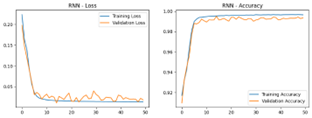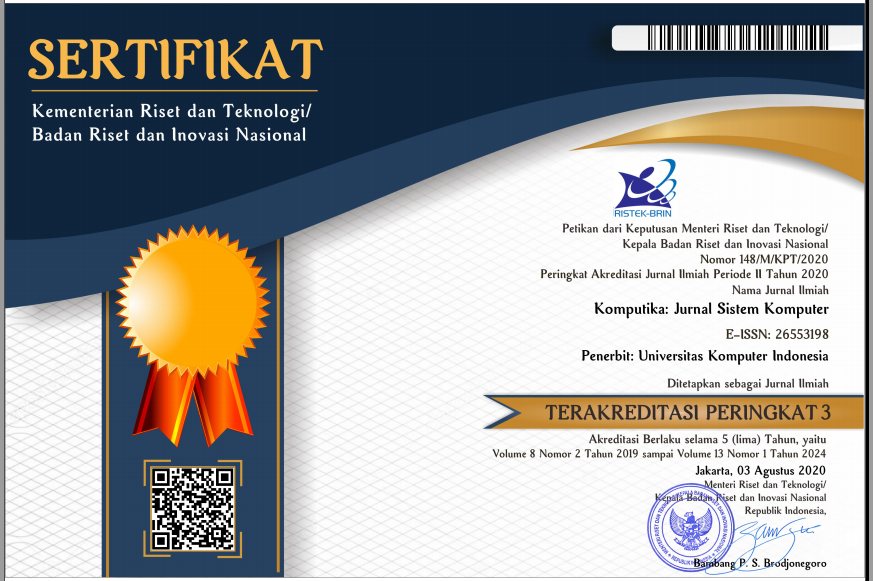Prediksi Kabut Menggunakan RNN dan LSTM dengan Attention Mechanism di Bandara Ruteng
DOI:
https://doi.org/10.34010/8e86yg15Abstract
Fog phenomena pose a significant challenge in aviation operations, particularly in regions with complex topography such as Ruteng Airport. Thick fog can reduce visibility and increase flight safety risks. This study aims to develop a deep learning-based fog prediction model by comparing the performance of Recurrent Neural Network (RNN) and Long Short-Term Memory (LSTM) enhanced with Attention Mechanism (AM). The dataset consists of 61,187 entries, covering hourly recorded weather parameters over the past ten years (2013–2023). The experimental results show that the addition of Attention significantly improves model performance. The RNN+Attention model emerges as the best-performing model with an accuracy of 0.9981, precision of 0.7755, recall of 0.76, and F1-score of 0.7677, along with the lowest number of False Positives. Meanwhile, the LSTM+Attention model excels in reducing False Negatives, making it suitable for systems prioritizing comprehensive fog detection. Models without Attention demonstrate perfect recall (1.00), but their low precision indicates overfitting. Overall, the integration of the Attention Mechanism enhances the balance between recall and precision and improves model reliability in handling data imbalance. The contribution of this research is that it can serve as a reference for future studies in developing artificial intelligence-based weather prediction models, particularly in addressing fog phenomena.
Keywords – Attention Mechanism; Long Short-Term Memory; Fog Prediction; Recurrent Neural Network
References
[1] R. Pahlavan, M. Moradi, S. Tajbakhsh, M. Azadi, and M. Rahnama, “Fog probabilistic forecasting using an ensemble prediction system at six airports in Iran for 10 fog events,” Meteorol. Appl., vol. 28, no. 6, 2021, doi: 10.1002/met.2033.
[2] A. Shankar and B. C. Sahana, “Early warning of low visibility using the ensembling of machine learning approaches for aviation services at Jay Prakash Narayan International (JPNI) Airport Patna,” SN Appl. Sci., vol. 5, no. 5, 2023, doi: 10.1007/s42452-023-05350-7.
[3] WMO, “Definition: Fog: A suspension of very small, usually microscopic water droplets in the air, reducing visibility at the Earth’s surface.,” World Meteorological Organization. [Online]. Available: https://cloudatlas.wmo.int/en/fog.html
[4] S. Sharma, K. Bajaj, P. Deshpande, A. Bhattacharya, and S. Tripathi, “Short-Term Fog Forecasting using Meteorological Observations at Airports in North India,” in ACM International Conference Proceeding Series, 2024. doi: 10.1145/3632410.3632449.
[5] D. K. E. Smith et al., “Forecasts of fog events in northern India dramatically improve when weather prediction models include irrigation effects,” Commun. Earth Environ., vol. 5, no. 1, 2024, doi: 10.1038/s43247-024-01314-w.
[6] C. Miller, K. Nicoll, C. Westbrook, and R. G. Harrison, “The effect of fog on atmospheric electric fields,” in Journal of Physics: Conference Series, 2024. doi: 10.1088/1742-6596/2702/1/012002.
[7] S. Cornejo-Bueno et al., “Statistical analysis and machine learning prediction of fog-caused low-visibility events at a-8 motor-road in spain,” Atmosphere (Basel)., vol. 12, no. 6, 2021, doi: 10.3390/atmos12060679.
[8] C. Miller, K. A. Nicoll, C. Westbrook, and R. G. Harrison, “Evaluating atmospheric electricity changes as an indicator of fog formation,” Q. J. R. Meteorol. Soc., vol. 150, no. 761, 2024, doi: 10.1002/qj.4680.
[9] C. Castillo-Botón et al., “Machine learning regression and classification methods for fog events prediction,” Atmos. Res., vol. 272, 2022, doi: 10.1016/j.atmosres.2022.106157.
[10] W. Li, X. Yang, G. Yuan, and D. Xu, “ABCNet: A comprehensive highway visibility prediction model based on attention, Bi-LSTM and CNN,” Math. Biosci. Eng., vol. 21, no. 3, 2024, doi: 10.3934/mbe.2024194.
[11] N. G. Dhangar, A. N. Parde, R. Ahmed, D. S. V. V. D. Prasad, and D. M. Lal, “Fog nowcasting over the IGI airport, New Delhi, India using decision tree,” Mausam, vol. 73, no. 4, 2022, doi: 10.54302/mausam.v73i4.3441.
[12] S. Kim, C. Rickard, J. Hernandez-Vazquez, and D. Fernandez, “Early Night Fog Prediction Using Liquid Water Content Measurement in the Monterey Bay Area,” Atmosphere (Basel)., vol. 13, no. 8, 2022, doi: 10.3390/atmos13081332.
[13] C. Peláez-Rodríguez et al., “Deep learning ensembles for accurate fog-related low-visibility events forecasting,” Neurocomputing, vol. 549, 2023, doi: 10.1016/j.neucom.2023.126435.
[14] C. Olah, “Understanding LSTM Networks.” [Online]. Available: https://colah.github.io/posts/2015-08-Understanding-LSTMs/
[15] Z. Zang et al., “A Modified RNN-Based Deep Learning Method for Prediction of Atmospheric Visibility,” Remote Sens., vol. 15, no. 3, 2023, doi:



















